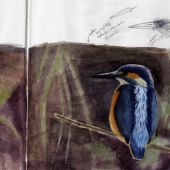Sketch Books
I started to sketch from life and filled my first sketchbook at the age of 16. Since then I’ve filled at least 200 sketchbooks and many loose sheets of watercolour paper. For me, filling a sketchbook is somewhat akin to the practice of a musical instrument. But my sketchbooks are not only a space in which to train: they have become the source of the “raw material” for my published sketchbooks.
My book “In Black stork Country” is illustrated with a selection of sketches from 17 field sketchbooks and 7 field journals of notes (for the texts). “The marquenterre” is based on 3 sketchbooks, loose leaves and 2 diaries of notes.
Thanks to the evolution in printing techniques I have also been able to use field sketches to illustrate other books, postage stamps, leaflets and nature trail panels.
Sketching in all its forms is very much alive and kicking today even if it has, like painting, died at least one death! This was affirmed by the recent major exhibitions by David Hockney “A BIGGER PICTURE” in which “en plein air” painting and sketchbooks took a large part. I found Hockney’s I Pad landscape sketches very refreshing - using the particularly luminous whites and greens to their best. Today we are today already a long way from drawing on computer screens in Photoshop - something I tried on an illustrator friend’s G4 back in 2006.
I may someday, try some of this ‘virtual’ sketching but for the moment I prefer to work on REAL BOOKS! There’s something great about the simplicity and liveliness of paper, graphite dust and watercolour!
Sketching an animal from life is exciting – you never know when it will move, fly off or run off or be hidden by branches…one has to be very fast and really see the subject, “holding” the image in your head for as long as possible. Sketching in zoos is great practice and zoos are a great place to learn. When I started out in sketching I did a lot of work in zoos and I was very fortunate to participate in Eric Ennion’s last Master Class at the Wildlife Park in Weyhill and to sketch with John Busby in Edinburgh Zoo. Nowadays I teach both adults and children in the zoos of Bettembourg and Amnéville but I still try to find some time to do some zoo work sometimes in preparation for certain species I will see in the wild in my travels.
Which reminds me of the time I was drawing the portrait of a young Long-Eared Owl taken down from its nest for me to draw. Knowing I had very little time, I worked extra fast and the owl, rather than trying to escape, sat there mesmerized by the sound of my pencil on the paper which was like that of a mouse in dried grasses!
My sketchbooks are sometimes thematic like those I did as part of the cycle “TIDEPOOLS” which “became” artist’s books and thus artworks in their own right. But if theyare used to make a published book the sketchbooks are dismantled and individual pages are sold as artworks. Other sketchbooks document a voyage like a week on Oeussant. In general, my books do not only contain field studies of birds and other animals but also of landscapes (finished watercolours), postmortem studies, and well as plant drawings, botanical studies and shadow paintings. And of course, I will use sketches in a traditional manner, as a starting point for a painting or larger drawing, on canvas.
Before I sign off on this theme – sketching “en plein air” is a great antidote for the lack of patience engendered by an overdose of watching that ‘1 second diaporama’, namely television, particularly in the case of young children and I use sketching and sketchbooks extensively in my teaching.










